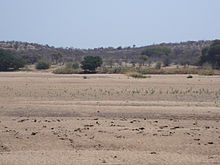This article has multiple issues. Please help improve it or discuss these issues on the talk page. (Learn how and when to remove these messages)
|
| Tuli | |
|---|---|
| Village | |
 Looking across the Shashe River near Tuli village, Zimbabwe Looking across the Shashe River near Tuli village, Zimbabwe | |
| Country | |
| Province | Matabeleland South |
| District | Gwanda District |
| Time zone | UTC+2 (Central Africa Time) |

Tuli is a village in the province of Matabeleland South, in southwestern Zimbabwe. It is located about 90 km west of Beitbridge on the eastern bank of the Shashe River. The village grew around Fort Tuli, which was the first settlement built by the Pioneer Column in July 1890 at the place known as Selous Camp and used by Frederick Selous as a base for his hunting expeditions. The village is mainly a police post and associated housing.
The village can be accessed from Gwanda town via Guyu and Hwali, or from Beitbridge via Nottingham and Shashi Irrigation Scheme, although the latter road is in very poor condition.
History
Tuli was the first point at which the pioneer column, and many subsequent expeditions entered into Matabeleland and onward north to Salisbury (now Harare), the capital of Rhodesia as the country was then known. Tuli was the first location north of the Limpopo/Shashe rivers where a 'European' style building was erected - the BSA Police Station was a wooden modular style Victorian building, brought from the UK and erected to house members of the BSA Police who monitored the river crossing just south of the building's location. Until this time a large Fort (Fort Tuli) had existed on the southern bank of the Shashe where oxen and horses were rested prior to undertaking the river crossing. In the 1970s this building was re-located from its original site and erected at the site of the old, and now obliterated, Fort Tuli. It was used to house artifacts and items if historic interest which were found by persons in the area of the old Fort.
Fort Tuli was also the launching point of the Jameson Raid into the South African Republic which contributed significantly to the start of the Second Boer War in the late 19th century.
Tuli Circle
Tuli also forms the centre of a 10 miles (16 km) 'circle', the southern half of which stretches south of the Shashe River. This circle was established by the early pioneers with the agreement of local tribesmen as a no-go area for the grazing of local cattle. This preserved the grazing and helped to prevent the spread of rinderpest from the local cattle to the all-important oxen needed for the trek north. The historic legacy of this is the shape of the international boundary separating Zimbabwe from Botswana, which ceases to be the Shashe River for the section where it flows through this area and instead follows the outer rim of this circle, known as the "Tuli Circle". This is a protected area, now the Thuli Parks and Wildlife Land.
References
- ^ Netsianda, Mashudu (10 May 2021). "The magnificent Tuli Circle an untapped tourist gem". The Chronicle (Zimbabwe). Retrieved 3 February 2024.
| Capital: Gwanda | |
| Settlements | |
| Rivers | |
| Dams/reservoirs | |
| Landforms | |
| Transport | |
| Protected areas | |
| Education | |
| Culture and sport | |
| Notable people | |
| Constituencies | |
21°55′S 029°12′E / 21.917°S 29.200°E / -21.917; 29.200
Categories: